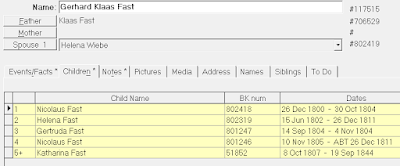In late 1811, a census was taken of the Elbing region
where many Mennonites lived. This city
was under a special administrative regime because in the late 1600s, the King
of Poland had used it as collateral for a loan from the Duke of Prussia. This led to a centuries-long dispute about
whether the loan had been repaid and whether the Prussian dukes (later kings)
could take the city’s revenues to repay the loan. In 1811, the city was still under a special
administration as a result. Thus, a
separate census was taken in 1811.
My 5-greats-grandfather, Gerhard Fast #660202
(1739-1828), had five siblings whom I have identified, and I am trying to piece
together their descendants. One of those
siblings was Klaas Fast #706529 (ABT 1745-1820), and he had a son Gerhard
#117515 (ABT 1774-1830) who lived in the village of Fürstenauerweide, which in
the Elbing region. Someone had entered
the birth dates of the younger Gerhard’s six children from the Fürstenau
Lutheran church book, and I found the death dates for five of those children
who died young in the same church book.
(Imagine how shattering it must have been to lose five of six children before
the age of nine.) Here is how the family
looked:
 |
| Gerhard Klaas Fast, Genealogical Registry and Database of Mennonite Ancestry, CD-ROM, version 6 as updated by author (Fresno: California Mennonite Historical Society, 2013), individual #117515. |
Then I got to wondering if he was in the 1811 Elbing
census, which was taken near the end of 1811, so I checked Adalbert Goertz’extraction. And I found him as expected
in Fürstenauerweide:
I’m sure it is him because the family data matches. Notice that no wife is listed – there is only
a blank in the space where the age of the wife would be shown. His first wife, Helena Wiebe died in October
1811, so it fits that she is not listed.
Three children’s ages are listed – 10, 8, and 3 years. He had three children still living, Helena,
Nicolaus, and Katharina, whose ages were 9, 6, and 4 years based on their exact
birth dates from the Lutheran church book.
Remember that ages in census records were not very exact back then, so
this fits well enough. Two of those
children, Helena and Nicolaus, died in late December 1811, but they are still
listed in the census. Since the census
was taken near the end of 1811, the family information fits the census.
The census also adds another useful piece of information –
he was an Arbeitsman, a laborer. This means that there is not much point in
searching for land records in Fürstenauerweide.
And it also tells us that they were poor. In 1819, Gerhard Fast and his second wife
Barbara Isaac and his remaining daughter Katharina emigrated to Russia, to start
a new life as a landowner in the village of Rudnerweide, Molotschna Colony.

No comments:
Post a Comment